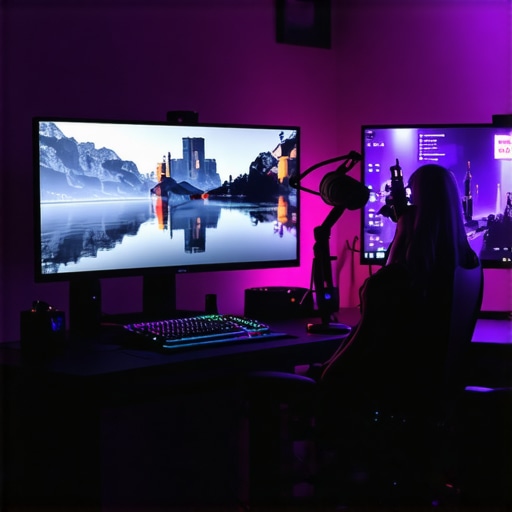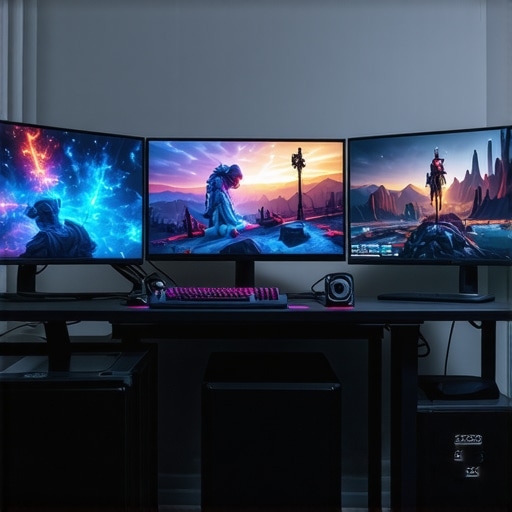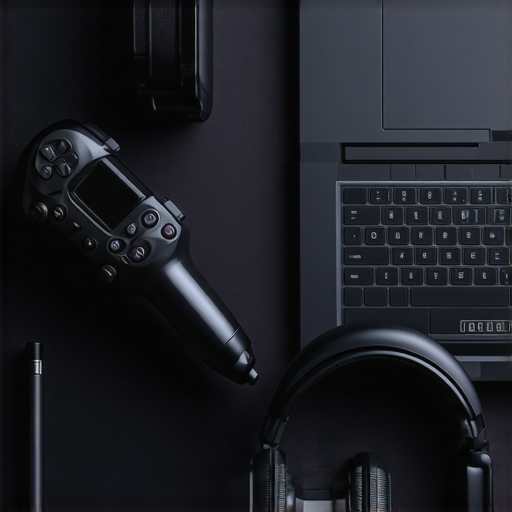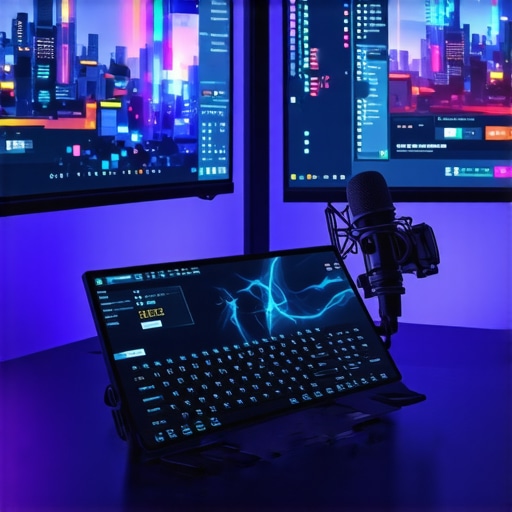Discovering the Perfect Gaming Laptop: My Personal Experience
It all started last year when I decided to upgrade my gaming and streaming setup. I remember spending countless nights researching the latest gaming laptops, trying to find one that could handle my demanding games and streaming needs without breaking the bank. After testing several models, I finally settled on a device that transformed my gaming experience and made streaming smoother than ever.
What Makes a Gaming Laptop Truly Stand Out?
From my experience, a great gaming laptop isn’t just about high specs; it’s about balancing performance, portability, and durability. I looked for models with powerful CPUs, top-tier GPUs, and fast SSDs, but also considered battery life and build quality. My favorite feature turned out to be the display — a high refresh rate screen made gameplay incredibly fluid and immersive. I also paid attention to cooling systems, as overheating can ruin long gaming sessions.
Streaming Setup Tips I Swear By in 2024
When it comes to streaming, I learned that having a reliable setup is crucial. I invested in a quality microphone, a good webcam, and an adjustable lighting setup, which all contributed to a professional look. The most important upgrade was my streaming PC, which I paired with my gaming laptop. For seamless live streams, I rely on dedicated streaming software like OBS, combined with a fast internet connection. If you’re interested in building a top-notch streaming station, check out this guide for the best equipment recommendations.
How Do I Balance Power and Portability?
This question has haunted me many times. As someone who loves gaming on the go, I needed a laptop that was lightweight yet powerful enough to run AAA titles smoothly. I found that models with a good balance of specs and weight exist, but sometimes compromises are necessary. For instance, I opted for a slightly heavier but more powerful machine for home use and a lighter ultrabook for travel. My experience shows that prioritizing your gaming and streaming needs will help you choose the right device.
Why is a High-Refresh-Rate Display So Important for Gamers and Streamers?
Having experienced both high and standard refresh rate screens, I can tell you firsthand that a 144Hz or higher display makes a noticeable difference in gameplay fluidity. It reduces motion blur and lag, giving you that competitive edge. For streamers, a smooth display helps in capturing high-quality footage, making your streams more engaging. If you’re serious about gaming and streaming, investing in a high-refresh-rate monitor or laptop display is worth it — I recommend reading more about the latest models on trusted sites like TechRadar.
If you’re passionate about gaming and streaming, I’d love to hear your experiences. Share your tips or ask questions in the comments below, and let’s build the ultimate setup together!
Optimizing Your Gaming Laptop for Streaming Success
Beyond hardware specifications, the way you configure your gaming laptop can significantly impact streaming quality. Prioritize updating your graphics and audio drivers regularly, as these updates often include performance improvements and bug fixes. Additionally, fine-tuning your in-game settings—such as lowering unnecessary visual effects—can free up resources, ensuring smoother gameplay and streaming performance.
The Role of External Devices in Elevating Your Stream
While a powerful laptop forms the core, external peripherals can elevate your streaming setup to professional levels. A dedicated microphone with noise-cancellation capabilities ensures clear audio, while a high-quality webcam captures your expressions vividly. Consider investing in an adjustable ring light to eliminate shadows and maintain a consistent appearance on camera. These accessories are crucial for engaging viewers and building a loyal audience.
How Can Advanced Streaming Software Enhance Your Broadcast?
Streaming software like OBS Studio or Streamlabs OBS offers extensive customization options that can make your streams stand out. Features such as scene transitions, overlays, and real-time chat integration allow for a polished presentation. Exploring plugins and plugins can add functionalities like automatic scene switching or multi-source recording, providing a seamless viewer experience. As the streaming landscape becomes more competitive, mastering these tools is essential for professional-quality broadcasts.
Would a Dual-PC Setup Be Worth the Investment?
Many seasoned streamers opt for a dual-PC setup to offload the streaming workload from their gaming machine. This configuration allows the gaming laptop to focus solely on gameplay, while a second dedicated PC manages encoding, overlays, and chat interactions. Although it requires a higher initial investment and more complex setup, the benefits include reduced lag, higher stream quality, and greater flexibility in stream customization. For those serious about streaming, exploring this setup can be a game-changer, especially with the latest tech guides available at this comprehensive guide.
What Are the Common Pitfalls to Avoid in a Streaming Setup?
One frequent mistake is neglecting the importance of internet bandwidth; a stable and fast connection is vital to prevent buffering and dropped frames. Additionally, overlooking proper cable management can lead to clutter and accidental disconnections. Overloading your streaming software with too many overlays or unoptimized sources can strain your system, leading to dropped frames or latency issues. Regularly testing your setup before going live and keeping a checklist of hardware and software updates can help you avoid these pitfalls and ensure a smooth streaming experience.
For those interested in elevating their setup further, exploring the latest in streaming hardware and software innovations can provide a competitive edge. Don’t forget to share your own tips or ask questions in the comments—building a community of knowledgeable streamers benefits everyone!
Embracing the Nuances of Hardware Optimization for Streaming
When I first started streaming, I underestimated how critical hardware fine-tuning could be. Over time, I learned that beyond having top-tier specs, understanding how to optimize my laptop’s settings made a tangible difference. For instance, adjusting the power management profiles to favor performance mode minimized lag and stuttering during intense gaming sessions. Additionally, I discovered that enabling hardware acceleration in streaming software like OBS could reduce CPU load, resulting in smoother broadcasts. These tweaks, while seemingly minor, accumulated to elevate my streaming quality significantly.
Reflecting on the Balance Between Hardware and Software Complexity
One of the more complex challenges I faced was managing the interplay between hardware capabilities and software configurations. As I integrated more overlays, scene transitions, and multi-source recordings, my system faced increased strain. I found that regularly reviewing my streaming setup—such as disabling unused sources or lowering rendering quality—helped maintain a steady stream. This dynamic balancing act requires not just technical know-how but also a touch of intuition; knowing when to prioritize performance over visual flair can be the difference between a good stream and a great one. It’s a continuous learning process, akin to tuning a musical instrument—every adjustment brings out better harmony.
How Do I Tackle the Limitations of Laptop Hardware for High-Quality Streaming?
From my experience, one of the most persistent questions is how to push a laptop’s hardware to meet high demands without overheating or sacrificing longevity. I’ve found that external cooling solutions, such as high-performance laptop cooling pads, extend hardware life and prevent thermal throttling. Moreover, choosing efficient encoding options like NVENC (NVIDIA’s hardware encoder) over software encoding can drastically reduce CPU load, freeing resources for gameplay and streaming. According to a 2023 report by TechRadar, leveraging hardware encoders can maintain high quality while preserving system stability—an insight I wholeheartedly endorse based on my own trials.
Another strategy I adopted was dedicating specific hardware resources to different tasks—using separate drives for game storage and streaming files, for instance, minimized read/write bottlenecks. These practices might seem technical, but they’re invaluable for anyone serious about streaming on a laptop. If you’re interested in more advanced hardware setups, exploring dedicated guides like this comprehensive equipment guide can be a game-changer.
Why Is Understanding System Bottlenecks Critical for Streamers?
In my journey, pinpointing system bottlenecks—whether CPU, GPU, RAM, or storage—has been crucial. I remember a particular stream where my frame rate suddenly dipped during high-action scenes. After some troubleshooting, I realized my RAM was maxed out, causing delays. Upgrading to faster memory modules and closing background applications made a noticeable difference. This experience underscored the importance of holistic system monitoring—tools like MSI Afterburner and Windows Task Manager help me keep an eye on resource utilization in real-time. Recognizing these bottlenecks early allows for targeted upgrades or adjustments, ensuring smooth streams and gameplay.
If you’re navigating similar challenges, sharing your experiences can be incredibly helpful. Drop your tips or questions in the comments—building a community of resourceful streamers benefits everyone.
Integrating External Devices for a Seamless Streaming Experience
While internal hardware optimization is vital, external peripherals have become my secret weapons. High-quality microphones with noise-cancellation, like the Shure SM7B, drastically improve audio clarity. Pairing this with a reliable webcam and adjustable lighting setup ensures viewers stay engaged. I also found that external capture cards, such as the Elgato 4K60, allow me to record and stream in high quality without taxing my laptop’s internal resources. These tools, combined with a well-organized workspace, create a professional environment that elevates my broadcasts and keeps viewers coming back.

For a visual reference on setting up an efficient streaming station, check out detailed guides and real-world setups shared by top streamers online.
The Future of Streaming Hardware: What Should You Watch For?
Looking ahead, I’m excited about emerging technologies like AI-driven noise suppression and advanced encoding algorithms. These innovations promise to make streaming smoother and more accessible. Companies like NVIDIA are pushing the boundaries with their latest GPUs, which include features tailored for streamers—improving quality while reducing system impact. Staying informed means regularly exploring trusted sources like this resource and experimenting with new tools as they become available.
Ultimately, my journey has shown that mastering your hardware and software setup is an ongoing process. Whether you’re a beginner or a seasoned streamer, sharing your experiences and continuously learning from the community makes all the difference. I’d love to hear your stories—what hardware tweaks or software tricks have transformed your streaming journey? Drop your insights below, and let’s grow together in this exciting digital space!
Harnessing Cutting-Edge Cooling Technologies for Peak Performance
One of the less obvious yet crucial aspects I delved into was advanced cooling solutions. During intense streaming marathons, thermal management becomes paramount, especially when pushing high-end hardware to its limits. I experimented with liquid metal thermal compounds and custom cooling pads, which significantly reduced temperatures and prevented thermal throttling. According to a detailed review by Tom’s Hardware, innovative cooling methods can extend hardware longevity and sustain performance during demanding tasks—an insight I can personally attest to from my prolonged streaming sessions. Implementing these solutions requires a meticulous approach but pays dividends in stability and performance.
Optimizing Software Encoding: Beyond Default Settings
While hardware is vital, mastering software encoding settings can unlock hidden performance gains. I discovered that switching from software encoding to hardware NVENC encoding, available on NVIDIA GPUs, drastically reduces CPU load, allowing for higher quality streams without sacrificing game performance. Fine-tuning preset profiles within OBS Studio, such as choosing a balanced or max quality setting, further enhances stream clarity. A 2023 report from PC Gamer emphasizes the importance of leveraging hardware encoders for streamers aiming for professional-grade broadcasts—something I have integrated seamlessly into my setup. Experimenting with these settings has transformed my streaming quality, making it more resilient during high-action scenes.
How Do I Future-Proof My Hardware for Emerging Streaming Trends?
This was a question I wrestled with as I sought longevity in my setup. Staying ahead of rapid technological advancements means investing in scalable hardware and adaptable software solutions. For instance, upgrading to a GPU with DLSS and AV1 encoding support ensures compatibility with forthcoming streaming standards, while choosing motherboards with ample PCIe slots allows for future expansion. The recent advancements documented by TechRadar highlight how AI-driven compression and real-time scene analysis are becoming mainstream, promising smoother streams with less bandwidth. Exploring these innovations and integrating them proactively keeps my setup future-proof and competitive. For those serious about staying ahead, I recommend exploring trusted sources like this comprehensive guide.
What are the most overlooked hardware upgrades that can dramatically improve streaming quality?
Reflecting on my journey, I found that upgrading my RAM to faster modules and expanding storage with NVMe SSDs offered immediate benefits, reducing latency and load times during streams. Additionally, external audio interfaces and high-fidelity microphones have elevated my sound quality, making interactions more engaging. These seemingly minor upgrades cumulatively enhanced the overall professionalism of my broadcasts. If you’re eager to delve deeper into these advanced tips, I encourage you to share your experiences or ask questions—building a community of resourceful streamers benefits everyone.
Integrating AI-Driven Tools for Advanced Stream Management
The advent of AI-driven tools has opened new horizons for stream management. I integrated AI-based noise suppression software, which adapts in real-time to background sounds, creating a cleaner audio experience. Similarly, AI scene detection automates switching between overlays based on gameplay context, reducing manual adjustments and streamlining production. A recent article by Ars Technica discusses how AI is revolutionizing content creation, offering streamers smarter, more efficient tools. Experimenting with these innovations has significantly reduced my setup complexity while enhancing broadcast quality. As these tools evolve, staying informed through trusted sources and community forums can help you leverage the latest tech to elevate your streams further.
What Role Do External Devices Play in Professionalizing Your Streaming Setup?
While internal hardware optimization is fundamental, external peripherals serve as the finishing touch. I invested in an external DAC (Digital-to-Analog Converter) for superior audio fidelity, and a multi-camera setup with HDMI capture cards allowed me to incorporate different viewpoints, creating a more dynamic broadcast. External lighting, such as adjustable ring lights and softboxes, ensures consistent visual quality regardless of ambient lighting conditions. These peripherals, combined with a well-organized workspace, foster an immersive viewer experience that keeps audiences engaged and coming back. For a detailed look at setting up such a professional environment, exploring dedicated guides and community showcases can be invaluable.

Visualize a high-end streaming station featuring multiple external devices, lighting, and camera setups for inspiration.
Things I Wish I Knew Earlier (or You Might Find Surprising)
Understanding Hardware Bottlenecks
Early in my streaming journey, I underestimated how critical it was to monitor system bottlenecks. I often blamed my internet connection when streams lagged, but it turned out my GPU or RAM was maxed out during intense scenes. Using tools like MSI Afterburner helped me identify these issues, leading to smarter upgrades and smoother broadcasts.
The Power of External Devices
Initially, I believed internal hardware was enough, but investing in external microphones, capture cards, and lighting made a huge difference. These peripherals created a more professional look and sound, engaging viewers more effectively and making my setup stand out.
Balancing Performance and Portability
As someone who streams on the go, I learned that a lightweight laptop with a good balance of specs is essential. Sometimes, sacrificing a bit of portability for better cooling or GPU power pays off, especially during marathon streaming sessions.
The Impact of Software Optimization
Fine-tuning streaming software settings, like enabling hardware encoding and adjusting bitrate, can significantly improve stream quality. I discovered that these small tweaks often yield better results than hardware upgrades alone.
Future-Proofing Your Setup
Thinking ahead with scalable hardware, such as supporting new encoding standards like AV1 or adding extra PCIe slots, helps keep my setup ready for upcoming streaming innovations. Staying informed through trusted sources ensures I don’t fall behind.
Resources I’ve Come to Trust Over Time
- Tom’s Hardware: Offers in-depth reviews and guides on cooling solutions and hardware performance, which helped me optimize my system cooling and stability.
- PC Gamer: Provides practical tips on software settings, hardware recommendations, and the latest trends in gaming and streaming tech, keeping me updated.
- MSI Afterburner: A free tool for real-time system monitoring and overclocking, essential for diagnosing bottlenecks and maintaining performance.
- Streamlabs & OBS Studio: Leading streaming software platforms with extensive community support and tutorials that improved my broadcast quality.
Parting Thoughts from My Perspective
Building a gaming and streaming setup that truly works requires a mix of understanding hardware limitations, leveraging the right external devices, and continuously optimizing software. My experience has shown that staying curious and proactive about new tools and tech, like those discussed at this resource, keeps the process exciting and rewarding. If this resonates with you, I’d love to hear your own tips or questions—let’s grow our streaming communities together!


Reading through this detailed overview really resonated with my own experience upgrading my streaming setup. I particularly agree with the importance of balancing power and portability when choosing a gaming laptop. Finding that sweet spot can be tough, but investing in dual-use devices—like a beefy machine for home and a lightweight ultrabook for travel—has really helped me stay flexible without sacrificing performance. I’ve also realized that optimizing software settings, especially enabling hardware encoders like NVENC, significantly reduces the CPU load and smooths out streaming during high-demand scenes. Have others experimented with different software presets or external cooling solutions to manage thermal issues? Sharing what’s worked for you might help newbies avoid some common pitfalls related to overheating or lag during prolonged streams.
This article really hits close to home, especially the emphasis on balancing power and portability. When I first started streaming on my gaming laptop, I underestimated how much thermal throttling could impact performance. Upgrading to a high-quality cooling pad made a noticeable difference, keeping temperatures in check during long sessions. Also, I found that switching to hardware NVENC encoding not only reduced CPU load but also improved stream stability, especially when streaming demanding AAA titles. It’s clear that investing in external cooling solutions plus optimizing software settings can significantly elevate your stream quality without necessarily splurging on the most expensive hardware. Has anyone experimented with liquid metal thermal compounds? I hear they can further improve cooling performance—any thoughts or experiences there? Ultimately, these tweaks have transformed my streaming experience, making it more reliable and professional-looking.